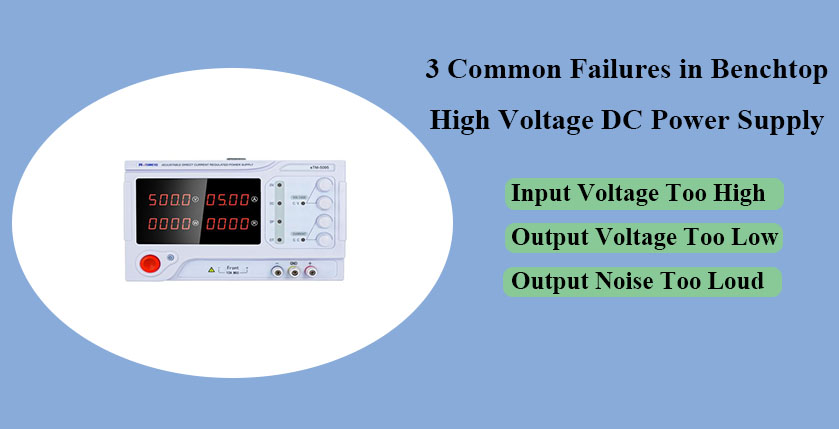High voltage power supplies, while usually very reliable, can fail in actual use. When your high voltage DC power supply encounters a problem, it is critical to troubleshoot it effectively and promptly.
We will detail 3 common failures and their solutions: input voltage too high, output voltage too low, and output noise too loud. By understanding the root causes of these issues and taking appropriate measures to solve them, you can ensure the stable operation of your high voltage power supply.

High Voltage DC Power Supply Input Voltage Is Too High
When the input voltage of a high voltage DC power supply exceeds the rated range, it can cause serious problems. If the input voltage of a high voltage power supply is too high, it will not only cause the system to not work properly, but may even cause the circuit to burn out. So what usually causes DC power supply input voltage to be too high?
- The output end is open or there’s no load.
- The load on the output end is too light, less than 10% of the rated load.
- The input voltage is too high or there is interference voltage.
To address this failure, adjustments can be made either to the load on the output end or to the input voltage range:
- Ensure that the load on the output end is not less than 10% of the rated load. If the actual circuit might operate without a load, then a dummy load with a rated power of 10% should be connected in parallel at the output end.
- Switch to an input voltage within a reasonable range. If interference voltage is present, consider adding a Transient Voltage Suppressor (TVS) diode or a voltage regulator in parallel at the input end.
DC High Voltage Power Supply Output Voltage Is Too Low
An excessively low output voltage can cause the entire system to malfunction. For instance, in microcontroller systems, a sudden increase in load can lower the supply voltage to the microcontroller, easily leading to a reset.
When DC power supplies operate under low input voltage conditions for extended periods, the lifespan of the circuit can be significantly reduced. Therefore, issues of low output voltage should not be overlooked. So, what are the common causes of excessively low output voltage?
- The input voltage is too low or the power is insufficient.
- The output lines are too long or too thin, resulting in excessive line loss.
- The voltage drop across the anti-reverse diode at the input is too large.
- The input filter inductor is too large.
For this type of problem, it can be improved by adjusting the power supply or replacing the corresponding peripheral circuits:
- Turn up the voltage or switch to a higher power input supply
- Adjust the wiring, increase the cross-sectional area of the conductor, or shorten the length of the conductor to reduce internal resistance.
- Use diodes with low on-state voltage drop.
- Decrease the value of the filter inductor or reduce the internal resistance of the inductor.
High Voltage Power Supply Output Noise Is Too Loud
It’s well-known that noise is a key indicator of the quality of AC to DC power supplies. In application circuits, the design and layout of the power supply can also affect the output noise. So, what are the common causes of excessive output ripple noise?
- The DC power supply is too close to noise-sensitive components in the main circuit.
- Decoupling capacitors are not connected at the power input ends of noise-sensitive components in the main circuit.
- In multi-channel systems, differential frequency interference occurs between the DC power supply modules of each channel.
- The grounding is handled improperly.
For such issues, improvements can be made by isolating control modules from noisy components or applying decoupling capacitors in the main power circuit:
- Keep power supply modules as far away as possible from noise-sensitive components in the main power circuit, or ensure proper separation between control modules and noise-sensitive components in the main power circuit.
- Connect a 0.1μF decoupling capacitor at the switch power input end of noise-sensitive components in the main power circuit, such as A/D, D/A converters, or MCUs.
- Use a multi-channel power supply module instead of several single-channel output modules to eliminate differential frequency interference.
- Opt for a more distant grounding system and reduce the total area of the ground loop.
ETOMMENS, as a professional variable DC power supply manufacturer, not only produces a variety of bench high voltage power supplies but also offers customization services based on customer needs. With nearly a decade of operation, we have accumulated a wealth of expertise in DC power supply technology and manufacturing capabilities. We are equipped to help you create custom designs that meet your specific requirements.
